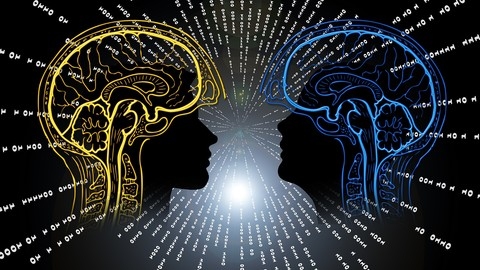Artificial Intelligence: Reinforcement Learning in Python
You’ll begin by exploring the explore-exploit dilemma through multi-armed bandit problems, implementing algorithms like epsilon-greedy, UCB1, and Thompson sampling.
From there, you’ll dive into the core concepts of reinforcement learning, including Markov decision processes, the Bellman equation, and value functions.
The course walks you through coding dynamic programming algorithms like policy iteration and value iteration for gridworld environments.
You’ll also learn Monte Carlo methods for policy evaluation and control, as well as temporal difference learning techniques like SARSA and Q-learning.
The syllabus covers using function approximation with linear models for more complex problems like the CartPole game.
To solidify your understanding, there’s a stock trading project where you’ll apply Q-learning to develop a trading strategy.
The course even includes supplementary sections on setting up your Python environment with libraries like NumPy, SciPy, Matplotlib, and TensorFlow, as well as effective learning strategies for machine learning.
Advanced AI: Deep Reinforcement Learning in Python
You’ll start with the fundamentals of reinforcement learning, exploring concepts like states, actions, rewards, policies, and Markov Decision Processes (MDPs).
The course dives deep into the Bellman equation, Q-learning, and epsilon-greedy algorithms, ensuring you grasp the theoretical foundations.
Next, you’ll get hands-on experience with OpenAI Gym, a powerful toolkit for developing and testing reinforcement learning algorithms.
You’ll implement techniques like random search, binning, and radial basis function (RBF) neural networks on classic environments like CartPole and Mountain Car.
The course then covers advanced topics like TD Lambda, which combines Monte Carlo and temporal difference methods.
You’ll also delve into policy gradient methods, tackling continuous action spaces with algorithms like REINFORCE on environments like Mountain Car Continuous.
Deep Q-learning, a breakthrough in combining deep neural networks with Q-learning, is explored in-depth.
You’ll implement it using TensorFlow and Theano on Atari games like Breakout, learning techniques like experience replay and handling partial observability.
The cutting-edge Asynchronous Advantage Actor-Critic (A3C) algorithm is also covered, with step-by-step code walkthroughs in Python.
You’ll gain insights into parallelizing reinforcement learning for improved performance.
Recognizing the importance of solid foundations, the course includes comprehensive reviews of Theano, TensorFlow, and Python coding best practices.
It also offers effective learning strategies tailored for machine learning and AI.
Cutting-Edge AI: Deep Reinforcement Learning in Python
The course starts with a review of fundamental reinforcement learning concepts like the explore-exploit dilemma, Markov Decision Processes, Monte Carlo methods, and Temporal Difference (TD) learning.
This ensures you have a solid foundation before diving into advanced algorithms.
You’ll then learn about three powerful deep reinforcement learning methods: Advantage Actor-Critic (A2C), Deep Deterministic Policy Gradient (DDPG), and Evolution Strategies (ES).
The A2C section covers the theory behind this actor-critic method and walks you through implementing it, including using multiple processes, environment wrappers, and convolutional neural networks.
For DDPG, you’ll first review Deep Q-Learning (DQN) before learning the theory and code implementation of DDPG, which combines ideas from DQN and policy gradients.
You’ll also get experience with the MuJoCo physics engine.
The ES section teaches you about this neuroevolution approach, including optimizing functions, supervised learning, and applying ES to challenging environments like Flappy Bird and MuJoCo tasks.
To accommodate different skill levels, the course includes sections on setting up your Python environment with tools like Numpy, Scipy, Matplotlib, Pandas, IPython, Theano, and TensorFlow.
There are also extra coding help resources for beginners.
Additionally, you’ll find lectures on effective learning strategies tailored for machine learning and AI, covering topics like prerequisite knowledge and how to approach the course material successfully.
Practical AI with Python and Reinforcement Learning
You’ll start by setting up your environment with Anaconda and Jupyter Notebook, ensuring you have the right tools for the course.
Next, you’ll dive into the fundamentals of NumPy and Matplotlib for data manipulation and visualization in Python.
This lays the groundwork for understanding machine learning concepts like supervised learning.
The course then provides a crash course in Pandas and Scikit-Learn, two essential libraries for data analysis and machine learning tasks.
With this knowledge, you’ll explore artificial neural networks (ANNs) and TensorFlow, a powerful library for building and training deep neural networks.
You’ll learn about convolutional neural networks (CNNs) and apply them to image datasets like MNIST and CIFAR-10.
This hands-on experience will prepare you for the core reinforcement learning concepts covered later in the course.
The course covers key reinforcement learning ideas like agents, environments, policies, rewards, and the Bellman equation.
You’ll work with the OpenAI Gym library, which provides a collection of environments for training and testing reinforcement learning agents.
Classical Q-learning algorithms are introduced, including table-based and continuous Q-learning implementations.
You’ll then move on to deep Q-learning (DQN), which combines Q-learning with deep neural networks for improved performance.
Excitingly, you’ll learn how to apply DQN to play Atari games, replicating the groundbreaking work that popularized deep reinforcement learning.
The course even guides you through creating your own custom OpenAI Gym environment, like a Snake game, and training an agent to play it.
Throughout the course, you’ll work on practical exercises and projects, solidifying your understanding of the concepts.
Modern Reinforcement Learning: Deep Q Agents (PyTorch & TF2)
You’ll start by coding a Q-Learning agent from scratch to solve the Frozen Lake environment, gaining a solid foundation in core RL concepts like Markov Decision Processes, value functions, and the exploration-exploitation tradeoff.
Next, you’ll dive into a deep learning crash course, learning how to handle continuous state spaces with deep neural networks.
You’ll code a naive Deep Q-Network (DQN) agent to play the CartPole game, analyzing its performance and limitations.
The course then takes you through implementing cutting-edge Deep RL algorithms from research papers.
You’ll read, understand, and code agents using techniques like Double DQN, Dueling Network Architectures, and more.
You’ll even learn to preprocess Atari game screens and stack them as input to your agents.
But it doesn’t stop at just coding - you’ll build a command-line interface for rapid testing and consolidate your codebase into an extensible class hierarchy.
You can even watch your agents play games in real-time!
The course covers both PyTorch and TensorFlow 2 implementations, ensuring you’re well-versed in the latest deep learning frameworks.
You’ll also find bonus lectures on installing OpenAI Gym and making your agents compatible with its new interface.
Reinforcement Learning beginner to master - AI in Python
You’ll start by understanding the Markov decision process, the mathematical foundation for modeling control tasks.
This will help you grasp concepts like policies, state values, and the Bellman equations.
Next, you’ll dive into dynamic programming techniques like value iteration and policy iteration to solve Markov decision processes.
The course then covers Monte Carlo methods, both on-policy and off-policy, for solving control tasks based on sampled experience.
Temporal difference methods like SARSA and Q-Learning are explored in-depth, allowing you to understand their advantages over Monte Carlo methods.
You’ll also learn about n-step bootstrapping techniques like n-step SARSA.
For continuous state spaces, the course covers state aggregation and tile coding methods.
It provides a brief introduction to neural networks, covering concepts like artificial neurons, network representations, and stochastic gradient descent optimization.
Deep reinforcement learning is a major focus, with dedicated sections on Deep SARSA and Deep Q-Networks.
You’ll learn techniques like experience replay and target networks for stable learning.
The course also covers policy gradient methods like REINFORCE, exploring parallel learning and entropy regularization.
Finally, you’ll learn about the Advantage Actor-Critic (A2C) algorithm, which combines policy gradients with value functions.
Throughout the course, you’ll implement these algorithms in Python, gaining hands-on experience with reinforcement learning concepts.
The course strikes a balance between theoretical foundations and practical implementations, ensuring you understand both the “why” and the “how” of reinforcement learning.
Modern Reinforcement Learning: Actor-Critic Agents
You’ll start by reviewing the fundamentals of reinforcement learning, including concepts like Monte Carlo methods and temporal difference learning.
This will prepare you for more advanced topics like policy gradients and actor-critic algorithms.
One of the key projects is teaching an AI to land a lunar module on the Moon using the REINFORCE policy gradient algorithm.
You’ll code the agent’s neural network “brain” and watch it learn to navigate this challenging environment.
The course then dives into actor-critic methods that combine policy gradients with temporal difference learning for improved performance.
You’ll implement cutting-edge algorithms like Deep Deterministic Policy Gradients (DDPG) and Twin Delayed DDPG (TD3).
These allow for continuous action spaces and can solve complex tasks like teaching an agent to walk.
The syllabus covers reading research papers, handling exploration vs exploitation, and coding techniques like replay buffers.
The course culminates with Soft Actor-Critic (SAC), a state-of-the-art algorithm that maximizes entropy for improved exploration.
You’ll get hands-on experience coding SAC in frameworks like Tensorflow 2.0.
Throughout, you’ll grapple with key concepts like overestimation bias and variance reduction for stable learning.
The syllabus is very coding-focused, guiding you through implementing these algorithms from scratch.
You’ll learn to interface with OpenAI Gym environments and develop a deep understanding of how these cutting-edge RL methods work under the hood.
Reinforcement Learning: AI Flight with Unity ML-Agents
You will start by setting up the necessary tools like Unity Hub and Anaconda, and then dive into the world of Unity ML-Agents.
The course begins with a basic 3D ball example, where you’ll train an agent to complete a task, giving you a hands-on introduction to reinforcement learning concepts.
Next, you’ll learn how to create 3D assets in Blender, including a low-poly terrain, rocks, and an airplane.
If you prefer, you can skip this section and use the provided assets.
Once you have the assets ready, you’ll set up a new Unity project and install ML-Agents.
Then, you’ll build a desert airplane racing environment in the Unity Editor, complete with a race path, checkpoints, and boundaries.
The course covers creating an aircraft area, defining variables, and implementing functions like ResetAgentPosition() and Rotate.cs.
You’ll also learn to develop an AircraftAgent and AircraftPlayer, handling input, movement, and training logic.
One of the highlights is training the aircraft agents using ML-Agents.
You’ll create config files, start the training process, and monitor progress using Tensorboard.
The course also teaches you how to introduce randomness to improve the agents’ performance.
After training the agents, you’ll move on to creating a complete game with menus, race logic, and a heads-up display (HUD).
This includes implementing game managers, race managers, and UI controllers for various screens like the main menu, pause menu, and gameover screen.
You’ll also learn how to add post-processing effects and create a second level with a snow theme, complete with water, rocks, and an updated race path.
Deep Reinforcement Learning: Hands-on AI Tutorial in Python
You’ll start by understanding the core concepts of reinforcement learning, including Markov Decision Processes, Bellman equations, and algorithms like Q-Learning and SARSA.
The course covers the key differences between reinforcement learning, supervised learning, and unsupervised learning.
Once you have a solid theoretical foundation, you’ll dive into hands-on projects to apply your knowledge.
The first project involves building an agent to solve a maze problem using Q-Learning.
You’ll create the maze environment, implement the Q-Learning algorithm, and visualize the agent’s learning process.
The second project is more complex – you’ll build a stock trading agent using deep reinforcement learning techniques like Deep Q-Networks.
This involves creating a market environment, preparing stock data, implementing an agent with experience replay, and training a deep neural network to make profitable trading decisions.
Throughout the projects, you’ll learn how to define a reinforcement learning problem, create environments, implement agents, and evaluate their performance.
The course also covers advanced topics like exploration vs. exploitation tradeoffs and using multiple features for more sophisticated agents.
By the end, you will have a solid understanding of reinforcement learning algorithms and the ability to apply them to real-world problems using Python.
The hands-on projects ensure you gain practical experience in implementing these powerful techniques.
Artificial Intelligence IV - Reinforcement Learning in Java
You will start by understanding the fundamentals of reinforcement learning, including different types of learning and its applications.
The course then dives deep into Markov Decision Processes (MDPs), a mathematical framework for modeling decision-making problems.
You will learn about MDP basics, equations, and how to solve MDP problems using techniques like the Bellman equation and value iteration.
Next, you will explore policy iteration, another method for solving MDPs, and compare it with value iteration.
The course then introduces Q-learning, a popular reinforcement learning algorithm, including its mathematical formulation and implementation.
You will apply Q-learning to practical problems like pathfinding and finding the shortest path.
The course also covers the exploration vs. exploitation problem, a fundamental challenge in reinforcement learning, and introduces the N-armed bandit problem and its applications in areas like marketing.
The course then moves on to deep reinforcement learning, which combines reinforcement learning with deep neural networks.
You will learn about deep Q-learning, including the epsilon-greedy strategy, experience replay, and its mathematical formulation.
Throughout the course, you will have opportunities to reinforce your understanding through quizzes and hands-on implementations in Java.
The course materials, including code and resources, are also provided for download.










